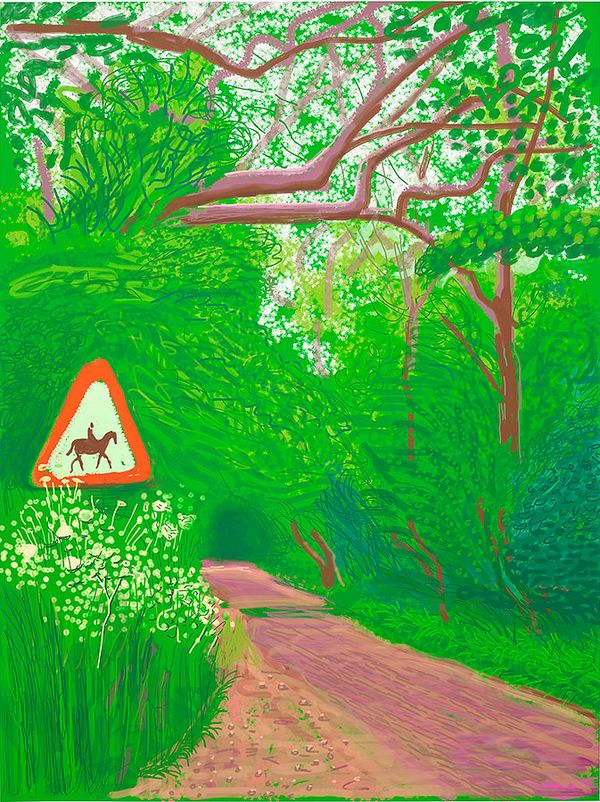David Hockney, The Arrival of Spring in Woldgate, East Yorkshire in 2011 (twenty eleven) - 30 May, 2011.
Phillips Paris is delighted to present a selection of highlights from our 2025 David Hockney auction, along with additional David Hockney prints and works on paper, available to view and for private sale. To kick things off ahead of the exhibition and auction, we're looking back at some of our favorite articles, videos, and gallery tours across the many seasons of David Hockney.
Paris Highlights Exhibition
7—18 April 2025
10:00am—6:00pm
PHILLIPS
46 Rue du Bac
75007 Paris, France (map)
For a runner – jogger, rather – there isn’t much of a difference between reward and punishment. Case in point: a winter spent logging (or often, avoiding) treadmill miles – and those slack minutes which are likely the most critical evidence of the theory of relativity – leads to the arrival of spring and the notoriously humbling first outdoor jog of the year. Yes, it’s still freezing in the morning, and yes, one’s only options are wet and wetter, but this is a special run, a diagnostic check-in with nature and the self, and for this season’s starter, we’ll be throwing pace out the window and instead spend some time thinking about David Hockney.
There is a distinct feeling that arises from the roadside sign in The Arrival of Spring in Woldgate, East Yorkshire in 2011 (twenty eleven) - 30 May, 2011, as it is our start and end point. This is already bad advice, of course – the professionals recommend tuning out our surroundings, but the moment we take off, the sign becomes our orienting object. Every following step is in service of seeing the back of the sign upon our return. This is a carryover of treadmill mental mathematics: OK, in two more minutes it’ll be five minutes, then that’s half of ten, which by then will be half of twenty, meaning at this point it’ll just be another half to get to half, and that second half is the final half and we’ll be good to go. Out here it’s more of an organic approach. The sign is here now, and it will be here when we’re done.
We will, however, mind the professional advice to move at a pace in which we can maintain a conversation, because the scenery is not to be missed. It is interesting to wonder if en plain air painting requires a certain amount of sky to qualify as we amble beneath the wiry green canopy. Hockney is a master of this relationship between natural and human-negotiated leisure, be it with his swimming pools or in the present work, where both the beauty and the concerns of the untamable are off to our sides, where they just manage to stay out of reach, and we instead enjoy the low-maintenance side of serenity.

David Hockney, The Arrival of Spring in Woldgate, East Yorkshire in 2011 (twenty eleven) - 19 February, 2011.
Soon we encounter the turnaround point. We can imagine this scene as it could have been experienced by the likes of Constable or Turner, only rather than taking a romantic view of things, we appreciate the way in which Hockney presents this little stretch of wood as a reminder of the season. Perhaps in the time of Hockney's forebearers the gate was manned and led to an estate where time stood still and tradition was rule and the right to roam didn’t exist, but no longer is that the case, and irrespective of anyone’s attempt to freeze the future, spring has returned with its dampness, its false starts, and its unrestrained inspiration.
On the return half, we snap back into the present when the smartwatch signals to our earbuds and a gentle, robotic voice calls out five ... kilo-meters. It is at this point when we remember that Hockney composed many of his springtime works on an iPad. Rather than feeling any less bucolic, however, we take in the idea with full force and unravel the thread a bit: it is indeed too simplistic and narrow-minded to think of any return to or experience within nature as any more authentic than another; after all, the Romantics and the Impressionists in their time sought the same arcadian sublime. It is instead the conservation of these disparate experiences and the mediums of capturing them – the conscious effort towards continuity – that mean more, and this is precisely what Hockney captures by way of his digital stylus. If there weren’t infinite ways to depict nature, there wouldn’t be an equal number of ways to enjoy it, both as spectator and composer. Up ahead we see the reverse of our start sign, now with its lovely, unpainted verso, as if to imply a wrong way of going about things, but we made it – sore, sweaty, and cold again – but we did it our way.
Recommended Reading
Sybil Andrews & The Grosvenor School >
